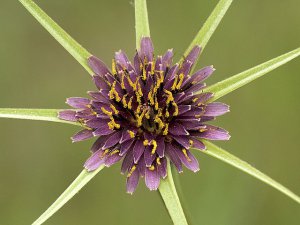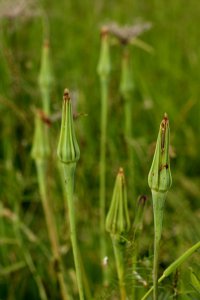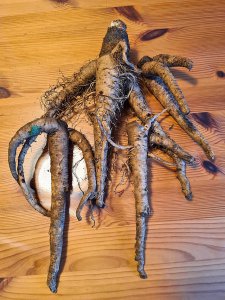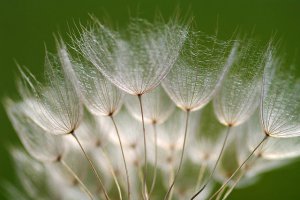A message from EatThePlanet.org: "We are happy you found us! We strive to be informative and accurate. Enjoy what you find here! Take a look at our new downloadable pdf eBook A Complete Guide To Foraging. We put a lot of work into this eBook and are very excited to share it with you." - Joe Forager(Owner)

Purple salsify (Tragopogon porrifolius) is a flowering plant that’s commonly found in the Western and Northeast US. Purple salsify grows similarly to other root vegetables like parsnips and carrots, and is found in the wild, and is cultivated for its roots.
Purple salsify is native to Southeast Europe and North Africa and it has been distributed across Northern Europe, North America, Southern Africa, and Australia. Its distribution is attributed to its usefulness as a food crop and ornamental flower.
Purple salsify goes by many names including common salsify, oyster plant, vegetable oyster, Jerusalem star, Jack-go-to-bed-at-noon, goatsbeard, or simply salsify. The name “Jack-go-to-bed-before-noon” comes from the manor at which the flower blooms. The plant flower opens up in the morning and closes after a short while, usually before noon.

Salsify’s Edibility and Culinary Use
This plant is closely related to dandelion and chicory. As with those plants every part of salsify is edible. Despite it being edible, salsify is most palatable during the early stages of development before the flower stalk and seed pod is produced.
The root can be eaten raw or cooked and tastes similar to a cross between a parsnip and an oyster.

Pan-roasting salsify roots are a great way to enjoy the flavors of this root. You start by rinsing and scrubbing the salsify roots. Then you peel them with a vegetable peeler and rinse again. Once rinsed, cut the salsify roots into 3-inch-long and 1/4-inch-thick pieces. Pan roast the roots with seasoning for about 15 minutes and finish with dill to enjoy its delightful flavor profile.
Salsify is mostly used as a food crop in Europe, where it has been consumed for centuries. It was introduced to the US in the 1700s as an ornamental flower and food crop. The plant was once popular in the US, but its popularity declined in the 20th century, however, purple salsify is seeing a resurgence in popularity due to its unique flavor and nutrient profile.
The young salsify shoots can be enjoyed much like asparagus. The sprouted seeds can be added to salads and sandwiches for extra nutrition and flavor as well.

Purple Salsify’s Health Benefits
The plant is high in Vitamin C, Vitamin B6, magnesium, potassium, and dietary fiber. It also contains anti-inflammatory compounds that may be beneficial for people with many different health issues.
Regulates Blood Pressure
One of the most notable benefits of purple salsify is its ability to regulate blood pressure. The plant contains a compound called sotolon, which has been shown to have a blood-pressure-lowering effect. Salsify is also a great source of potassium (1 serving contains 15% of your daily recommended value) which helps in regulating blood pressure.
Aids in Digestion
The dietary fiber in purple salsify helps to improve digestion and the bulkiness of the vegetable makes you feel fuller for a longer time.
Purple Salsify is rich in inulin, which is a prebiotic and helps feed good bacteria in your gut. This helps boost the immune system and improves health by keeping harmful bacteria at bay.
Aids in Detoxification of the Liver and Body
The liver plays a vital role in detoxifying and processing nutrients, and purple salsify is rich in sulfur compounds like glucosinolates that aid liver function. This results in better nutrient absorption and health benefits due to the increased metabolism of nutrients into cells for energy; which in turn helps detoxify the body.
The anti-inflammatory compounds in purple salsify also help to reduce inflammation throughout the body, which can lead to better health overall.
Improves Bone Health
Purple salsify contains high amounts of calcium, iron, magnesium, phosphorus, potassium and zinc. All of these minerals are important in maintaining healthy bones because they help to keep the body supplied with adequate levels of calcium, which is what makes up bone mass.
This is particularly important for menopausal women because it has been found that during this time, women are at a higher risk for developing osteoporosis due to hormonal changes. Adding purple salsify to your diet can help offset some of these risks.
Purple Salsify Cautions
Every part of the purple salsify plant is non-toxic and safe to eat. Some parts may be unpalatable as the plant grows older, however, rarely will humans suffer from indigestion unless you have allergies to plants that are in the Dandelion family of plants.
It’s important to note the feature that separates purple salsify from other look-alike plants. When you break a part of the plant off, even a tiny part of a leaf, you should immediately see a milky white sap or juice come out of the damaged section. While not poisonous, it can be quite sticky when dried and is immensely difficult to wash off if you get it on your skin or clothing.
When harvesting, take caution in removing the plant from the soil. Simply pulling the plant up from the base will probably cause the stem to break from the roots. Instead, use a digging tool, stick, or your fingers to remove the dirt around the root so you can pull it out quickly with no issues.
Conclusion
Purple salsify is a very healthy and nutritious plant that should definitely be considered for inclusion into your diet. It’s not only an anti-inflammatory powerhouse, it also contains many nutrients that can help you to maintain optimal health.
While purple salsify might not become as popular or readily available as carrots or potatoes, it certainly is worth searching for at your local farmer’s market or grocery store. With a taste that is reminiscent of artichokes, this vegetable should not be missed.
—————
Written by Jared DeValk
Jared DeValk is an author, writer, and entrepreneur who in his free time can be caught hiking, planting berry bushes, or doing home repairs and improvements. Jared's varied life experience and passion for research empassions him to write knowledgeably about many topics such as , Health & Wellness, Real Estate, Finance, Business, Cryptocurrency, Home Improvement, Agriculture, Camping/Hiking, and many more. Jared can be reached directly for speaking, marketing, and writing inquiries at JaredDeValk.com.
See our privacy policy for more information about ads on this site
Many of our readers find that subscribing to Eat The Planet is the best way to make sure they don't miss any of our valuable information about wild edibles.






